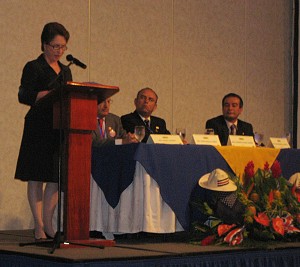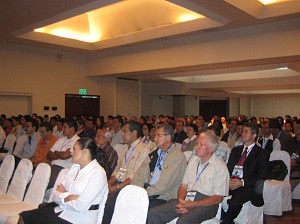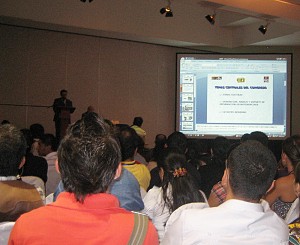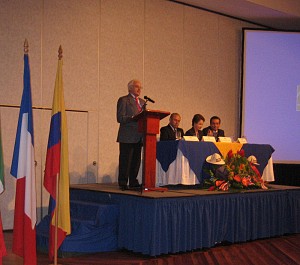Regional Association for Surveyors in Latin America under
discussion
Pedro Cavero attends the X International Congress on
Surveying, Cadastre, Geodesy and Geomatics
San José, Costa Rica, 18–20 September 2008
|

Ms.
Eugenia Flores Vindas, Minister of Science and
Technology, Costa Rica making her welcome address at the opening
ceremony. Other speakers were Prof. Pedro Cavero, Eng. Jorge Badilla Pérez
and Eng. Juan Manuel Castro Alfaro |

Audience at the X International Congress on Surveying, Cadastre,
Geodesy and Geomatics in Costa Rica. |
Prof. Pedro Cavero, FIG Ambassador for Latin America, attended the
X International Congress on Surveying, Cadastre, Geodesy and Geomatics that
was held in San José, Costa Rica, 18-20 September 2008. The conference was
organised by the Colegio de Ingenieros Topógrafos de Costa Rica CIT/CFIA and
co-sponsored by FIG. 360 participants from Costa Rica and several
neighbouring countries attended this bi-annual congress.
The X International Congress on Surveying, Cadastre, Geodesy and
Geomatics
In the technical programme there were 25 papers, four on geodesy, four on
surveying, six on cadastre, three on valuation, three on urban planning,
three on coastal surveying, and one on geomatics and on gender issues (“Female
Colleagues in the 21st Century”). The congress included also a
commercial exhibition with major companies in surveying business.
A specific focus in the congress was given to gender issues. Today there
are 150 female surveyors in Costa Rica and their professional role is
increasing every day. At the congress there were two specific events
dedicated for them, one technical session and presentation at the closing
ceremony.
The Opening Ceremony on the 18th September started with the National
Anthem followed by welcome address of the President of the Colegio de
Ingenieros Topógrafos, Eng. Juan Manuel Castro Alfaro. He expressed
his thanks to FIG for its support to the profession and in particular to the
Latin American associations, where much has been done but still much should
be done in the near future. Special thanks were addressed to the FIG
President, whose absence was regretted but understood, and to Prof. Cavero
as the FIG representative, whose involvement in working for the Latin
American countries is well-known and appreciated within the region.
A welcome greeting was given by the President of the Colegio de
Ingenieros y Arquitectos de Costa Rica, Eng. Jorge Badilla Pérez, who
underlined the importance of this congress for the surveying profession and
for other engineering disciplines as well.
Prof. Cavero congratulated the organisers in his speech, bringing
greetings from President Stig Enemark underlining the importance of
this congress for all Latin-American countries as a starting point for
establishing a regional association for the Latin American surveyors. The
aims for such an association should be to work for the profession and
professionals and for the whole society in Latin America. He also
congratulated CIT and CFIA for organising the FIG Regional Conference in
2007 and for producing the Costa Rica Declaration Integrated Coastal Zone
Management.
Finally Ms. Eugenia Flores Vindas, Minister of Science and
Technology, gave a short speech congratulating the Colegio, emphasizing the
importance of this international congress. She also offered all support from
the government for developing the final conclusions of the congress, mainly
to projects or needs related to the coastal zone development. She pointed
out the relevant role of the coastal areas in the future and expressed her
thanks to and congratulated FIG, the Colegio and the surveying profession
for the most important Costa Rica Declaration, a document that should be
given to the governments to work with.
On the 19th September there was the hand over of the Spanish version of
the Costa Rica Declaration from FIG to the Colegio by Prof. Cavero, who
underlined the big concern of FIG in strengthening all human rights and
promoting welfare and emphasising the continuous work of FIG with the United
Nations and its agencies including the World Bank. Mr. Castro Alfaro thanked
FIG for the valuable work in making the report and confirmed delivering it
to the different governmental departments in Costa Rica and further offered
it to the foreign delegates of the congress to bring it to their government.
On the 20th September at the closing ceremony the congress conclusions
were presented. The closing remarks were given by Eng. Olman Vargas
Zeledón, General Manager of the Colegio Federado de Ingenieros y
Arquitectos de Costa Rica, CFIA, followed by a typical “parrillada”
(barbecue) where the participants had the opportunity to taste excellent
food, listen to very nice music and see very beautiful national dances.
Regional Surveyors’ association for Latin America
On the 19th September there was a meeting for the international
delegates, representatives from Costa Rica and the FIG representative to
talk about the establishment of a surveyors’ association for Latin America.
This Latin American surveyors association would link professionals of the
whole continent in all fields of common interest whether they are
professional, educative or related to free movement of labour, etc.
The meeting was attended by colleagues from Costa Rica, Panamá, México,
Colombia, Venezuela and USA. It was chaired by the Mr. Castro Alfaro,
President of the Costa Rican Colegio, CIT, who talked about the need of
tightening links of friendship and collaboration among the different
national associations and expressed his full support to the FIG proposal of
creating such an association for Latin America.
Prof. Cavero, the FIG ambassador for the region, gave a short overview of
the latest experiences of developing such regional organisations and
highlighted some of the reasons to create such a body:
- The asymmetry of the countries in the region in surveying
profession. This creates a big challenge for the development of the
profession for colleagues in countries where surveyor's profession and
associations exists. In some countries in Latin America, such as El
Salvador, Nicaragua, Honduras, Guatemala, Perú, Ecuador, the surveying
profession and association do not exist; while in others, such as
Paraguay, Bolivia, even if the association exists, it has a very poor or
no active at all; and in some others, such as Chile, although there are
universities teaching surveying courses, the profession does not exist
as such, as there is no professional association and it seems to be
difficult to create one.
- The regional association, strongly supported by FIG, with the help,
when needed, from the United Nations, the World Bank etc., could work as
a first step to come into these countries. It could show the
stakeholders the relevant role and importance and need of surveying
professionals for a harmonic development of their country; to offer them
a possibility of educating young students of their country at
universities established in neighbouring countries - such is the case in
Central America, where we can find faculties teaching surveying
profession in Costa Rica (three universities), Panamá (two
universities), Puerto Rico (two universities). These countries should
not spend money for the moment in creating new faculties but instead
they could give scholarships for students to go abroad, to countries
with the same language, similar idiosyncrasy, not that far from their
home and with an excellent educational level. Once these new
professionals return to their home countries, they could together with
those who are now members of the civil engineering associations could
create their own professional association. This is not an easy task to
implement, but when done with enthusiasm and effort, could pay an
enormous gratification for everybody. This proposal should be sold to
politicians and other stakeholders in these countries. This proposal has
been generated with the full support from FIG at its highest level. The
implementation can include other international bodies whose
participation will be considered beneficial.
- Establishment of this association should be considered as a project
whose development and leadership belongs to the professional
associations; regional here meaning all Latin American countries. FIG
will always be there to help them, to advise them and to support them
whenever needed.
- Another target for the association will be to facilitate mobility of
professionals in the whole continent, mainly by recognising university
degrees by all countries in the region and by promoting mutual
recognition of surveying profession until it becomes a truth.
At the meeting several speeches from representatives from different
countries were presented, all of them being very interesting and showing in
many cases national characteristics. This was e.g. the case presented by
Eng. Leoncio Olvera, former President of CITAC (México, now a member
association of FIG), who told that in his country there are more than
300,000 surveying professionals, most of them not belonging to any
association, and the province ones without any link between them and with a
big need for some kind of a union and co-operation. Although he was very
pessimistic about any success in this field, he emphasised the need for the
universities in Mexico to teach something more than “pressing a button”
courses and to give integrated education in fields such as land management,
rural and urban planning, valuation, etc. This is what he understands is the
future of the profession and to make the students excellent “thinkers”
instead of simply “makers”.
The representative from Colombia, a Civil Engineer very much related to
surveying, was very enthusiastic with the proposal and offered to work for
it. The same happened with the representative of Venezuela (for almost the
first time Venezuela was present at an FIG event) The situation in Venezuela
is very similar to México regarding the difficulties in bringing
professionals to any association. In this case is not clear if there is more
than one faculty offering surveying curricula. The colleagues from Panamá,
who were present also at the meeting last year, were ready to work and
support the project with all their efforts.
As a result of the meeting a committee was created to bring the project
further. The members of the committee are:
- Coordinator: Eng. Daniel Acuña, Costa Rica
- Members:
- Eng. Rolando Cerrud Ballesteros, Panamá
- Eng. César Augusto Ruiz, Colombia
- Eng. Linda Vélez, Puerto Rico
- Advisors:
- Eng. Arturo Palencia, México
- Eng. Francisco Ortega, USA
- Eng. Santiago Borrero, Colombia (to be invited)
- Consultant and support: Prof. Pedro J. Cavero, FIG
It was agreed that there will be close communication between the
committee members and reporting system.
More to read:
Prof. Pedro J. Cavero
30 September 2008
|

Audience at the congress. |

Pedro Cavero making his welcome address. |
|


























